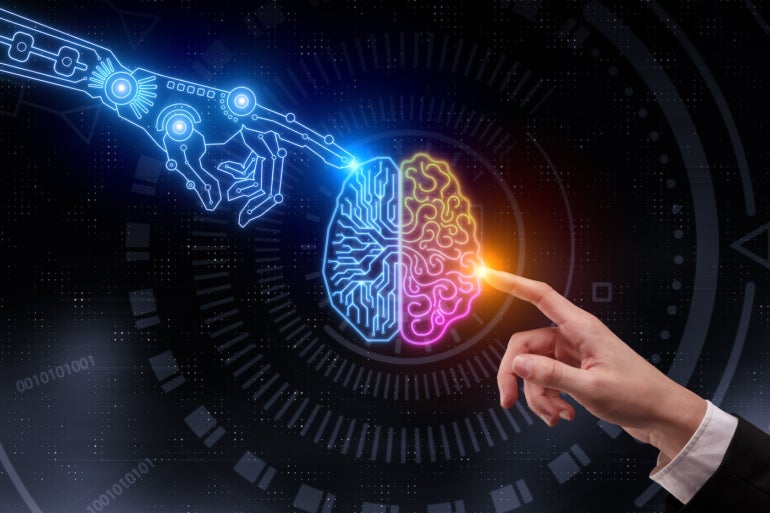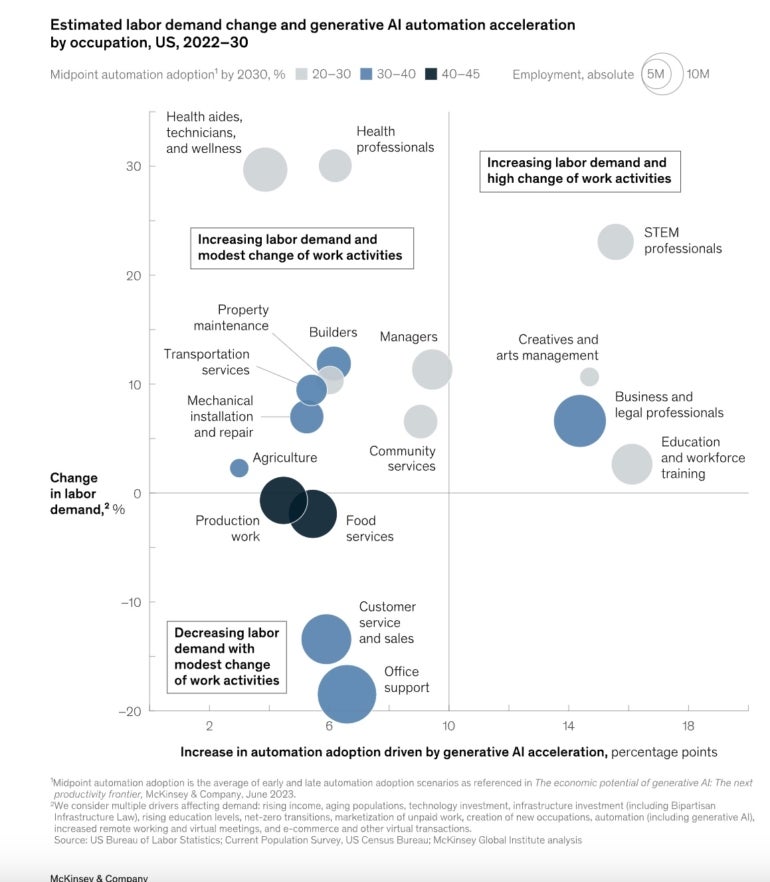
Discover how businesses use generative AI and automation and how they will affect the future of work, based on McKinsey’s report.
Generative AI will change, but not replace, many of the jobs now held by employees in the U.S., McKinsey found in its 2023 report “Generative AI and the future of work in America.”
Jump to:
Generative AI may increase U.S. labor production, McKinsey found. It could increase productivity by 0.5% to 0.9% annually through 2030. Generative AI is included in a pool of wider automation technology in the survey as well. Total productivity growth could increase by 3% to 4% annually with all automation technologies taken into account.
However, there are caveats. The 3% to 4% estimate depends on a “midpoint” of adoption, which will require enthusiastic adoption by both public and private stakeholders. Another possible pain point is the time it will take employees to learn and become comfortable with new tools.
The report pointed out the importance of guidelines like the White House’s voluntary agreement with generative AI makers and the industry’s Frontier Model Forum.
SEE: Technology Council of Australia and Microsoft say AI will transform the country — while Microsoft has a vested interest in OpenAI (TechRepublic)
“When machines take over dull or unpleasant tasks, people can be left with more interesting work that requires creativity, problem-solving, and collaborating with others,” wrote report authors Kweilin Ellingrud, Saurabh Sanghvi, Gurneet Singh Dandona, Anu Madgavkar, Michael Chui, Olivia White and Paige Hasebe.
“Workers will need to gain proficiency with these tools and, importantly, use the time that is freed up to focus on higher-value activities. When managers automate more of their administrative and reporting tasks, for example, they can spend more time on strategic thinking and coaching,” the McKinsey report stated.
The fields most exposed to generative AI are expected to add jobs through 2030, albeit slower than comparable jobs, the report found.
STEM jobs will see both increasing demand for workers and a high degree of changes to their day-to-day work due to AI and automation, McKinsey said. How exactly everyday work will change depends on both individual choice and industry trends. “The biggest impact for knowledge workers that we can state with certainty is that generative AI is likely to significantly change their mix of work activities,” the report stated.
The fields most likely to be both affected by AI and see a decrease in demand are customer service/sales and office support. However, several fields that can expect to see tasks transform as generative AI is applied to them — STEM and also business/legal professionals, creatives and educators — will see an increase in demand.
Figure A

Automation overall was estimated to take over tasks, accounting for 21.5% of the hours worked in U.S. jobs by 2030. Including generative AI in that mix increases the share of automated time to 29.5%.
Countries across the world are working on establishing regulations around generative AI for other reasons outside of the shift in labor, including concerns about privacy, inaccuracies and use of copyrighted material.
“There’s a big fear that AI is going to eliminate lawyers or writers, or, [that] it’s going to take a lot of those jobs,” said Sanjay Poonen, CEO of Cohesity (and former COO of VMware), in an interview with TechRepublic. “It’s the same way as when everyone thought about the automobile or anything that came in that ultimately made people more productive.”
While healthcare is the area expected to open up the most jobs in the future, tech is also hiring, despite the high-profile layoffs this year. McKinsey estimates a 23% increase in demand for STEM jobs by 2030. After all, it reasons that “companies of all sizes and sectors” need people who know tech and those who can help expand companies’ existing digital transformations. Tech workers will be in demand in fields like banking, insurance, pharmaceuticals and healthcare.
“I view generative AI especially as an extremely powerful tool to help you get a first draft of something better,” Poonen said. “If generative AI and ChatGPT could be used to help me get a first draft, it makes me more productive as opposed to being viewed that technology eliminates somebody’s job.”